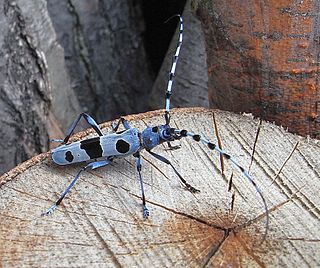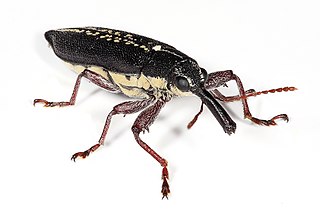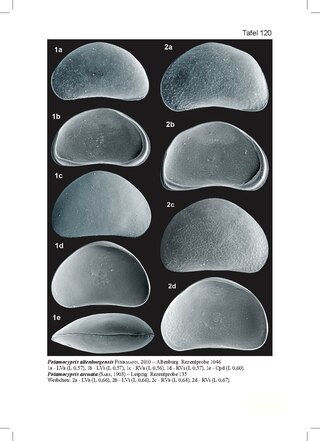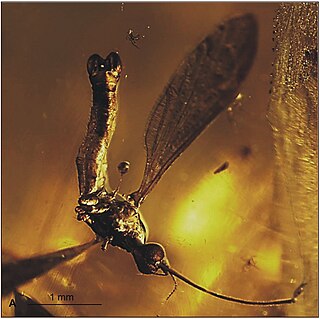
Marrella is an extinct genus of marrellomorph arthropod known from the Middle Cambrian of North America and Asia. It is the most common animal represented in the Burgess Shale of British Columbia, Canada, with tens of thousands of specimens collected. Much rarer remains are also known from deposits in China.

Antennae, sometimes referred to as "feelers", are paired appendages used for sensing in arthropods.

The Anthicidae are a family of beetles that resemble ants. They are sometimes called ant-like flower beetles or ant-like beetles. The family comprises over 3,500 species in about 100 genera.

Belidae is a family of weevils, called belids or primitive weevils because they have straight antennae, unlike the "true weevils" or Curculionidae which have geniculate (elbowed) antennae. They are sometimes known as "cycad weevils", but this properly refers to a few species from the genera Parallocorynus and Rhopalotria.

The Diplostraca or Cladocera, commonly known as water fleas, is a superorder of small, mostly freshwater crustaceans, most of which feed on microscopic chunks of organic matter, though some forms are predatory.

Electromyrmococcus is an extinct genus of mealybug in the Pseudococcidae subfamily Rhizoecinae. The genus currently contains three species, all from the early Miocene, Burdigalian stage, Dominican amber deposits on the island of Hispaniola.
Potamocypris is a genus of ostracod crustaceans in the family Cyprididae. There are currently 44 extant species of Potamocypris. The majority of the species occur in freshwater habitats; only a few species of the genus colonize marine brackish coastal waters.
Potamocypris steueri is a species of ostracod crustaceans in the family Cyprididae, subfamily Cypridopsinae found in marine brackish waters of the Mediterranean Basin as well as in brackish coastal waters of the Black Sea and the Caspian Sea.
Potamocypris variegata is a species of ostracod crustaceans in the family Cyprididae, subfamily Cypridopsinae. It is mainly found in ponds with rich aquatic vegetation, more rarely in slowly flowing streams. The species is distributed throughout Europe, but is also known from North America.
Potamocypris unicaudata is a species of ostracod crustacean in the family Cyprididae, subfamily Cypridopsinae. It is abundantly found in ditches and ponds near the sea shore, where freshwater slightly mingles with sea water. It is known from both Europe and North America.
Potamocypris smaragdina is a species of ostracod crustacean in the family Cyprididae, subfamily Cypridopsinae. It is known from both Europe and North America.

Potamocypris arcuata is a species of ostracod crustacean in the family Cyprididae, subfamily Cypridopsinae. It is mainly known from the southern areas of the Palaearctic.

Haidoterminus is an extinct genus of ant in the Formicidae subfamily Haidomyrmecinae, and is one of only nine genera placed in this subfamily. The genus contains a single described species Haidoterminus cippus and is known from one Late Cretaceous fossil which has been found in North America.

Elephantomyia (Elephantomyia) brevipalpa is an extinct species of crane fly in the family Limoniidae. The species is solely known from the Middle Eocene Baltic amber deposits in the Baltic Sea region of Europe. The species is one of six described from Baltic amber.

Elephantomyia (Elephantomyia) bozenae is an extinct species of crane fly in the family Limoniidae. The species is solely known from the Middle Eocene Baltic amber deposits in the Baltic Sea region of Europe. The species is one of six described from Baltic amber.

Elephantomyia (Elephantomyia) longirostris is an extinct species of crane fly in the family Limoniidae. The species is solely known from the Middle Eocene Baltic amber deposits in the Baltic Sea region of Europe. The species is one of six in its genus described from Baltic amber.

Elephantomyia (Elephantomyia) pulchella is an extinct species of crane fly in the family Limoniidae. The species is solely known from the Middle Eocene Baltic amber deposits in the Baltic Sea region of Europe. The species is one of six described from Baltic amber.

Gerontoformica is an extinct genus of stem-group ants. The genus contains thirteen described species known from Late Cretaceous fossils found in Asia and Europe. The species were described between 2004 and 2016, with a number of the species formerly being placed into the junior synonym genus Sphecomyrmodes.

Camelomecia is an extinct genus of stem-group ants not placed into any Formicidae subfamily. Fossils of the single known species, Camelomecia janovitzi, are known from the Middle Cretaceous of Asia. The genus is one of several ants described from Middle Cretaceous ambers of Myanmar.

Bradoponera is an extinct genus of ant in the Formicidae subfamily Proceratiinae, and is one of four genera of the subfamily. The genus contains four described species Bradoponera electrina, Bradoponera meieri, Bradoponera similis, and Bradoponera wunderlichi. The species are known from several Middle Eocene amber fossils which were found in Europe.















